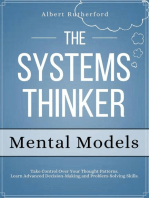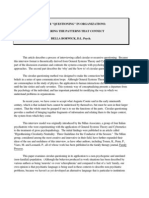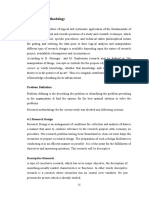Change Management in A Human Systems Model: Four System Types
Change Management in A Human Systems Model: Four System Types
Uploaded by
philirlCopyright:
Available Formats
Change Management in A Human Systems Model: Four System Types
Change Management in A Human Systems Model: Four System Types
Uploaded by
philirlOriginal Description:
Original Title
Copyright
Available Formats
Share this document
Did you find this document useful?
Is this content inappropriate?
Copyright:
Available Formats
Change Management in A Human Systems Model: Four System Types
Change Management in A Human Systems Model: Four System Types
Uploaded by
philirlCopyright:
Available Formats
6 Tremont Street | Newburyport, MA 01950
www.optionsforchange.com
Change Management in a Human
Systems Model: Four System
Types
Alan J. Slobodnik
Options for Change
Co- authored by:
Deborah Slobodnik
Options for Change
Presented at the HR Strategies in the M&A Process Conference
Toronto, April 30, 1998
Executive Summary
This presentation focuses on the system types component of a human systems change
management model. We will begin with a brief review of human systems theory, and the
dynamic relationship between the change agent and the target system. We will then
introduce our Onion Rings Model and examine each of the four system typesClosed,
Random, Open and Synchronouswhich comprise its first ring. For each system type we will
provide a discussion of its characteristic beliefs and behaviors. We will consider each in its
enabled and disabled versions and illustrate these with case examples.
We will then demonstrate how the model can be used in change management applications.
We will briefly introduce our assessment instrument, the Systems Type Indicator, and
explain its use in identifying system preference and quantifying a system's enablement.
After a review of structural system characteristicsfeedback loops and flexibility and
cohesion axeswe will consider the critical guiding principles for changing systems.
Introduction
Human Systems
Experience has taught us that human systems is the piece that's most overlooked as people
are working with organizations. Everyone has their own model for how to divide up the
different aspects of an organization, the different pieces that need to be included. Ours is a
human systems model. There's no rocket science here, nothing earth shattering about this
model. It just shows that in addition to vision and business goals and organizational
structure and work processes, there's a missing piece and the missing piece is the human
systems.
Those of you who are familiar with general systems theory from one field or another will
notice some second order cybernetics here. When we work with a system that's "out there,"
we're not somehow objective observers who sort of lob in an intervention on the system.
It's not like that at all. The interventions that we select are based on our own system
preferences. What we call our "boundary profile" affects how we deliver those interventions.
There's a highly complex interaction between us and the system that we're intervening on.
What we will focus on here is our relationship as change agents, with the systems that we
are working with and embedded in. We think you will find this model very useful.
voice (978) 255-2575 | fax (978) 255-2576 | email: info@optionsforchange.com
The Onion Rings Model
Our Onion Rings model has six rings, three of which are primarily diagnostic, and three that
are primarily interventionist, or tactical. But, as with any abstraction, that's not an inviolate
distinction. When we talk about the model we often talk about all six rings together. As it is
a little bit hard to digest all six rings at once, this discussion will start with the first one,
system types.
Most of you are familiar with the MBTI, the Myers-Briggs Type Indicator [1], and its four
categories. You've heard people say, "I am an INTJ", for example. Well, we like to think of
our model as the systemic MBTI. Now, obviously, we don't have the notoriety that Myers-
Briggs does yet. We would like to at some point. But just as Myers-Briggs has chosen what
they think are the four essential dimensions or characteristics of personality, what we
believe we have here are the six dimensions, or preferences, of systems and systems
thinking. And before we explain the four system types that make up the first ring, we'd like
to talk briefly about the difference between a systems model and an individual model;
between a personality model and a systemic model. There are some very dramatic
differences that are easy to miss and we don't want to do that.
Now, people have commented to us that a six-ring model is too complicated. Is it possible
to get rid of some rings or collapse some rings? There are a number of reasons why we
can't. Every time we have tried to do that we found that we were missing an essential
element in describing systemic behavior. When you have all these rings together there is
not an interaction on an individual level, on a team level, on a departmental level, on an
organizational level, or on a global level that you can't accurately describe. If we took one of
the rings out, that wouldn't necessarily be true.
There's also, to our way of thinking, something really cool about having 1,728 possible
"boundary profiles" [2]. With three or four characteristics in each ring all operating
independently of each other, we have a lot of possibilities to think about in terms of
describing systems 1,728 to be exact. Now, we've been through Human Dynamics
International Training [3], Myers-Briggs, Hermann Brain Dominance [4], and a lot of other
personality kinds of indicators. They all have their place, and they're all very valuable. But
the consistent feedback we get from people who have gone through them, is that they're
worried about being pigeonholed. They don't want to be labeled. And this model doesn't do
that. It's less confining because it has such a lot of possibilities, and because its dimensions
are always expressed in terms of preference rather than characteristic.
People get very intimidated by systems and systems thinking. It feels like mumbo jumbo,
it's complicated, it's hard to understand, it's vague but nothing could be further from the
truth. If you've actually read any general systems theory you will know that it's actually
solidly scientific. It enables us to make the soft stuff into hard science. There's no need to
start thinking in very complicated ways about systems thinking. How a system comes to be
is quite straightforward. When Subsystem A, which has certain characteristics, and
Subsystem B, with its own characteristics, come together they form a new and different
system through a complex but very describable negotiation. That's all that systems thinking
is about the formation of systems through the negotiation in real time of the boundary
preferences of all the systems involved. It does get more complicated, obviously, as more
systems are involved. For instance, with twelve people you would have a more complex
negotiation than the dyadic negotiation of relationship you would have with two. But it's still
just as easily describable in scientific terms. This model facilitates that description.
Joining with the System
As change agents who have worked in real systems, we all know it's foolhardy to assume
that the target system is interested in change. It may or may not be. It may be interested
in some completely different change from the change you have in mind. The target system
is just being itself. There's no need for judgment about it; it's just being the system that it
voice (978) 255-2575 | fax (978) 255-2576 | email: info@optionsforchange.com
is. Now, if we want to get it to change, where is the burden of responsibility for making this
change happen? The system may or may not accept that responsibility. It may have no
interest whatsoever in change. So, as change agents, we have to discover how to join with
that system in order to influence it. When we fail to do that we start blaming the system
and saying, "There's something wrong with this system." We get this magical thing called
resistance as if resistance was a characteristic of the system. Resistance isn't a
characteristic of the system. It is a characteristic of the interaction between a target system
and the other systems that are trying to get it to do something different. If you think about
it, a system never needs resistance until it confronts change. They're satisfied with doing
what they're doing. And when some external or internal force starts changing, they
suddenly get labeled resistant. When you join with a system properly, you won't get any
resistance at all. There's no need for resistance. We must recognize ourselves as change
agents and understand the power we can have to be influential.
There is an important difference between individual models and systemic models. In
systems theory, there's a recognition of homeostasis. But just as in physics there is a law of
inertia, which states that a body at rest tends to stay at rest, so is there a law that states
that a body in motion tends to stay in motion. Yes, homeostasis is there, but the desire to
grow and change is also there. And you can draw out the more functional parts of the target
system by changing your own boundary profile. Yes, of course there are physical laws to be
dealt with, but there's a lot more flexibility than people ever imagine. Systems thinking is
about context, not about characteristics.
Multiple Realities
One of the cornerstones of systems thinking is multiple realities and respect for multiple
realities. What's the point of judgment? A judgment is simply our vantage point, our bias
coming into play when we look at somebody else's system. Why should I have more respect
for my own preferences than for the preferences of another? When you think of it that
simply, it's kind of ridiculous to have judgments. Judgments result when our emotions are
tied up with our preferences. In fact, every system is equally entitled to be the system it is,
as we all are. And when you enter a system with respect for its right to exist, you have
much greater potential for leveraging the possibilities for change. On the other hand, people
will smell out judgment early on and will be very turned off by it.
The Four System Types
A Wide Angle Lens
First of all, let us give you a little bit of context. While we place a high value on individual
models like the MBTI and Human Dynamics, and others, we feel that this model provides
you with a different lens a wide angle lens. A system can be anything from a large
organization to an individual in a particular context. Because we all know we act differently
in different contexts; they bring out the best and worst in us. We're dynamic. So, a system
can be an individual, it can be a team of people, it can be a larger division or department of
an organization. You can even use this lens to look at a whole organization.
Our underlying assumption is that there are certain interdynamics and behaviors that create
a critical mass of operation, behaviors that are larger than any one individual. So, in the
middle of a change effort, when we feel there's one individual who really needs to change
especially if that person's in a leadership position we're usually missing the point. Most of
the time it's the system and the processes in place that are creating the problematic
behavior. We have to be very careful when we start looking at individuals. The model is
most effective in looking at the critical mass of behavior. When you get a group of people
together, it takes on certain characteristics that make it different from any one individual's
behavior.
voice (978) 255-2575 | fax (978) 255-2576 | email: info@optionsforchange.com
Family Systems Origins
We realize that there are other models like this around. Most of them, though, are models
of businesses. The Entrepreneurial Company, The Clan things like that. And while they're all
valuable, when you start to define systems in terms of a business model instead of universal
attributes, your model lacks a little flexibility. This human systems model can be applied to
your family, to your school, to your company. It describes universal characteristics. And a
change agent could describe herself as an anthropologist in the companies she works with.
Your initial goal is to come in as a good anthropologist to try to understand and discover
what the system is that you're working with. And this model has a lot of breadth and
flexibility.
Credit for this model goes to David Kantor [5], who is a mentor of ours. He did a lot of
research on these system types. But these originally come from the family systems branch
of systems thinking, which in fact, comes from the anthropologist, Gregory Bateson [6].
This really evolved out of his work with different systems and cultures. We learn from him
that there are different ways we can operate to be effective if we operate with
understanding and withhold judgment.
No Pure Type; No Best Type
The first critical assumption is that no system is a pure type. Some models divide the world
neatly into fours. We do have four system types here. But in fact, a system is never just
one or another. They are all some combination of these things. Typically, there is one
predominant system type and other lesser, contributing types. You will see predominant
characteristics and secondary characteristics in a system. You will see that the best systems
have characteristics from each, which give them flexibility and cohesion. It is rare, however,
to find a system where all four types are represented in equal measure.
This also challenges somewhat the notion especially in the OD world that the open system is
the best model. We think, while all of us accept that there is certainly a need for more of
the open system, there are also some values and assumptions that go along with it that
sometimes get the whole profession into trouble. The most practical example of that is
consensus. Everybody believes in consensus, but it doesn't always work in every situation.
We sometimes find ourselves stuck saying, "It's not okay, anymore, for anybody to make
any kind of top down decision." Well, that's disabled. Because sometimes more closed
system thinking is necessary to the ability to make a decision and announce it. Once in a
while it has to happen. So, an important assumption here is that each of these system types
has value. It may not be your personal favorite, but it works for some people.
Enabled and Disabled Systems
Another consideration to bear in mind is that a system can be enabled or disabled within its
type. Enabled systems are the ones in which the customer is completely satisfied, it
produces the results it wants, and it can respond to change. However, that same system
can look very disabled when things change. For example, let's say you're talking about a
very enabled high tech company. They're producing software, everybody's happy, and
they've got a certain way of doing things that's working for them. Now, when competition
becomes more of an issue they've got to be able to change. They've got to be able to get
the product to market quicker. All of a sudden, the same system can look very disabled
because it's not able to respond to change. You'll find that enablement is on a continuum,
really, more than being a black and white situation. So, remember those words enabled and
disabled.
The Closed System: Beliefs and Behaviors
We use four icons to represent the four basic system archetypes. These are emblematic of
how the different systems are organized. We'll first consider the Closed System. Most of us
in middle age grew up in closed system families. Most of the schools we went to were closed
systems. We think there's a huge misunderstanding and also knee jerk reaction to closed
voice (978) 255-2575 | fax (978) 255-2576 | email: info@optionsforchange.com
systems as being bad things. Closed systems are much more hierarchical, there's authority,
there's rank. You have people who have their own parking space that kind of thing. In a
closed system, you'll see top-down decision-making, you'll hear expressions like, "You pay
your dues; you work your way up." Strong loyalty is a common trait in closed systems. One
of the first characteristics that tells us we're dealing with a closed system, is when we find
that people have been there twenty years, thirty years, two generations. People come and
they stay; they marry the system. You'll find a lot of secrecy here, resistance to change,
and lack of innovation. You'll find a lot of fear in a closed system. That's sort of our gut level
diagnostic indicator of a closed system how much fear is there. If there's a lot of fear you're
talking about a closed system. You can walk into a random system dressed any way you
want, talk to anyone you want to, and they'd feel perfectly free to talk to you. In a closed
system that would never happen. You wouldn't dare do that. You have to get seven
signatures to go in and talk to somebody. A lot of large banks and insurance companies,
and certainly the military, are examples of large closed systems. When you're in a closed
system, the organization comes first. The individual is not as much seen or respected in a
closed system as in other kinds of systems, because it's all about the organization. Some
people like that, some don't. But it behooves us all to learn how to work with closed
systems.
Disabled Closed Systems
Disabled closed systems often become the targets of change agents. In disabled closed
systems the leadership can be not just strong and authoritarian, but tyrannical and
disempowering. Many of the current change management models are geared toward
changing a closed system. And that's something to keep in mind because in our experience,
they don't apply as well in other systems.
Enabled Closed Systems
We find that the enabled version of the closed system often gets lost due to some "throw
the baby out with the bathwater" kind of thinking. But there are some good things about
closed systems. There's a clear chain of command. And that can be very useful, especially in
a crisis. There's strong leadership. And We think people are craving that to some degree.
Enabled closed systems have efficient work processes. Many manufacturing organizations
are closed systems. Their survival dictates that they find the best work processes. When
you're dealing with a bank, it's nice to know that it opens on time, it closes on time, and for
the most part your transaction is going to be handled efficiently. A lot of good processing
goes on in closed systems. In an enabled closed system, you'll usually find lower error
rates, predictable and cyclical goal setting, performance measures and metrics, and
effective performance management. When you look at an enabled closed system you see
structure, you see processes, and you see a lot of accountability measures. And those are
not necessarily bad things. Those are characteristics of a closed system that should
probably be present in all systems. And we can borrow those things from the closed system
without becoming a closed system.
Examples and Discussion
The classic example of a closed system is the military, but it's kind of interesting to see
what's happening in the United States military today. The same thing that's happening in a
lot of our other industries is also happening in the military. The speed of change, the speed
of warfare has increased. And they're finding that the closed system has its limitations, one
of those dynamic tensions. There was no way that the guys in the tanks in Desert Storm
could check back with the general who was sitting somewhere in Kuwait to find out what
they should do next. They're being pushed more toward a system of local control, but
retaining a system of shared values, and a system of strong chain of command. It's very
interesting that even that system, which archetypally is probably one of the most closed
institutions we know, has realized there's a limit to that closed system. There are some
good things that they're trying to keep, but also some limits that they really need to change
as the speed of change goes up.
voice (978) 255-2575 | fax (978) 255-2576 | email: info@optionsforchange.com
There's an interesting paradox about response time in a closed system. On the one hand, it
only takes one person the person at the top who has the power to make that decision to
change the entire course. On the other hand, for that decision to get operationalized on the
shop floor is a whole different story. The CEO tells the functional vice president, who tells
the middle manager, who tells the first line supervisor, who has to tell the workers. One
person can make the decision, but implementing the decision can be a real problem. Also,
the quality and low error rate that we associate with a closed system can suffer when the
controls and accountabilities get too closed. This is what happened on the assembly lines in
the auto factories. People had become so unhappy with their jobs and the lack of
empowerment, they were literally leaving wrenches somewhere in the car so that there
would be a rattle you could never find. There's a lot of interesting dynamic tension in a
system that's very real.
A closed system becomes disabled when it's very slow to change. One example of a very
adaptable, enabled closed system is Disney World. It took us about a nanosecond to get
with the program when we got down there. You get on the monorail and they tell you
exactly where you should and should not sit. We were watching a light and sound show,
with our daughter and we put her up on something like a fence behind us so she could see
better. Within ten seconds somebody was there very politely and unobtrusively saying, "I'm
sorry, she's not allowed to sit there." So there's a very quick reaction. You can see the
benefits of the efficiency of the closed system. Disney also provides a good example of
dynamic tension in how these system types work together. The creative group at Disney is
going to be more of a random system. And when you have the random system embedded in
a closed system, there's probably going to be more tension than is comfortable for a lot of
creative people.
The Random System: Beliefs and Behaviors
The polar opposite of the closed system is the random system. Sometimes people don't
even recognize this as a system type. It's like a herd of cats. This is where you get people
who are individuals first, who happen to be working together in a system but may not even
necessarily want to be working in an organization. One of the characteristics of a random
system is that if you're the smartest kid on the block, if you've got the latest tricks, then
you get a tremendous amount of personal power and recognition. In a closed system people
have to be there for a certain length of time, and have to pay their dues, work their way up.
That's how they get recognition, that's how they get authority and power. In a random
system hierarchy is not respected at all. As a matter of fact, it's very hard to make decisions
because in a random system people resist any type of decision making or authority.
Random systems are very much influenced by the individual. There's a lot of conflict in
random systems; they like it, it's interesting. And people who don't understand that find
them conflict ridden. In fact, disabled random systems are conflict ridden, but conflict is a
necessary part of the energy in any random system. Don't try to implement any rules or
regulations. They're going to be totally resistant, because it's individual-based. Competition
is good, it's interesting, and it sparks a lot of innovation.
In random systems the work is what's important, not the organization. You won't find a lot
of loyalty in a random system. You move right on down Silicon Valley depending on what's
hot. Many high tech companies are random systems. People in high tech are extremely
smart. What they're interested in is the technology. The organization is just the vehicle for
developing technology and not one that's necessarily welcomed by most of them. There are
always certain people on the verge of leaving to go somewhere else. Most of them have an
entrepreneurial spirit. The organization is unwanted baggage for them. It's very hard to get
any kind of closure or cohesion or consensus in a random system. Arts agencies, graphic
design, advertising, the arts a lot of those tend to be random systems.
voice (978) 255-2575 | fax (978) 255-2576 | email: info@optionsforchange.com
But it's not only artsy organizations like that. We have done some work with a large city
government, and it's a huge random system. Everybody is working extremely hard and
trying to react within certain limitations. But it's a very reactive, response kind of system to
what's happening, what's hot, what's going to make the newspaper, that kind of thing. It's
very energetic and very random in certain ways while elements of the other system types
are present, as well. Again, no system is a pure type. And you may find a big discrepancy
between the espoused way of operating versus the actual.
Enabled Random Systems
Some people have trouble seeing random systems as enabled at all. Random systems are
very loose. And when we look at the change model you'll see that there's a necessary
balance between how cohesive a system is how much togetherness there is and how flexible
it is. That's a tension that you have to hold. Random systems are the most flexible kinds of
system. And with that you get responsiveness. They have a lot of innovation, free thinking,
and creativity. They're flexible enabled random systems and they're certainly respectful of
individual needs. If you had to leave early to go to your kid's soccer game nobody would
care. In a closed system, you can't go because the hierarchy is afraid everyone will want to
go.
Disabled Random Systems
Now, in the disabled version, there's a lot of chaos and too much conflict. There's a lot of
duplication of effort because there's a lack of cohesion; the left hand doesn't know what the
right hand is doing. There's no mutual problem solving. Everybody's going off and doing his
or her own thing. And very rarely do they get together. And even when they do get together
and make a decision, nobody follows it. They're crisis oriented, they're always working in
reaction to everything. And it's very hard, almost impossible, to get closure.
Examples and Discussion
We can give you a good example of how as consultants it's a good idea not to go in with the
idea that you're going to open up every system and be open system with everybody. We
were working with a very small manufacturing company. It was a boat manufacturer. They
had fifty employees and they had no supervisors. There was a shop manager who had
responsibility for all fifty employees. And the owner also felt completely free to go to the
shop, look over somebody's shoulder and say, "No, I think you should do it this way." It was
a very random system and they had no closed system strategies. Of course their big
problem the reason they called us in was quality. There was no quality control. Their boats
were literally going out the door with holes in them. Boats were sinking as they were being
put into the water because no one was checking to see if all the holes had been properly
plugged. So, the first intervention was setting up a supervisory structure and a quality
hand-off so that people would sign off as the work went from one station to another. They
had to see that all the steps were done properly so that they didn't wait till the end to
address problems or worse, never address them at all.
The Open System: Beliefs and Behaviors
The third system type is the open system, which again, is the ideal of a lot of people. And it
does contain a lot of what we're striving for in terms of empowerment, multiple
perspectives, diversity, a flatter hierarchy, consensus, communication all of those things.
We're all interested in those things and lots of techniques and strategies have been
developed to promote them. It's all very important stuff. In an open system you'll find
direct, open communication. Diversity is valued. People really are listened to and it's okay
to think differently from other people. You'll find individual responsibility and cross training.
Anything that flattens the hierarchy and gets people to work together and come to
consensus is all part of the open system in its enabled form.
voice (978) 255-2575 | fax (978) 255-2576 | email: info@optionsforchange.com
Enabled Open Systems
Real open system skills are in very short supply in our society. One of the reasons the open
system is in vogue today is because it's been underrepresented. American industry in the
1950's was a closed system environment. IBM is perhaps the best example. And now
industry is dying for more open system. But many people don't recognize the disadvantages
and the disabled parts of the open system. People grossly underestimate the complexity of
the skill set. They think that this is somehow just going to happen. Well, the skill set has to
be built in. There's a skill set in each one of these system types.
Disabled Open Systems
One of the things that we don't talk about much is the disabled open system. What you'll
find is that people in a disabled open system can't make decisions. It's totally circular. You'll
find false consensus. People can have a lot of trouble with consensus. Often what passes for
consensus is not consensus at all. There's a lot of "all talk and no action" in the disabled
open system. When you look at the espoused versus the actual, the open system is the
most espoused system there is and least actual system there is.
The open system can be conflicted about the role of power and leadership. In a systems
model and in general systems theory there is hierarchy. There's hierarchy in our body. You
can chop an arm off but you can't chop off the head. Certain things are more important
than others. And things cannot be totally flat. It's a law of the natural universe to have
hierarchy. While open systems have a flatter hierarchy and possibly a rotating hierarchy,
the need for leadership doesn't go away. And you may find a lot of denial about that, too.
We do a lot of work with teams. And we've seen people get paralyzed by having to take a
team leadership role. One team leader in a small company we were working with last week
had come up with some good ideas and he wanted to influence people but he was afraid to
put a stake in the ground. He was afraid people would follow what he wanted to say. And he
didn't know what to do. He was holding back. Physically, he was jumping up and down from
his chair, wondering whether to say what was on his mind. We talked with him afterwards
and we said, "You've got the right balance. People want to know what you think. Don't hold
back." There's a difference between influencing people and banging them over the head
with it to make them do things your way. That's the sort of trouble that the open system
ideal is getting us into.
Examples and Discussion
We saw another great example of the dynamic tension between the open and closed
systems when we were working with an executive team at an automotive company. It was
an IS team with global responsibilities, and they were really struggling with their
organizational model. The leader there was a very closed system guy, a vice president, and
the group really wanted to be much more open. So, the compromise they struck was really
graphic, it was great. Even though he was closed he knew that his survival and his career
depended on the input of his most trusted advisors. So he said, "Okay, how about this? I'm
going to go around the room and ask everybody exactly what you think and what you feel
and get all the opinions out on the table." And then he pointed to a manager from Germany,
and he said, "And I want you to get me one of those old World War I Kaiser hats. Then
when it comes time to make the decision, I'm going to put my Kaiser hat on and I'm going
to say what it is that we're going to do. And then I expect everybody to close ranks and do
it." It's perfectly legitimate under certain models to say, "Okay, now we're going to make a
decision and we're going to move forward and that's going to be that." And actually it
worked. People loved it, because they loved the clarity of it. They did not have a workable
decision-making model before. They lost their way between having input and making the
decision and reaching consensus. It was a breath of fresh air and a sigh of relief when he
suggested this model to them.
voice (978) 255-2575 | fax (978) 255-2576 | email: info@optionsforchange.com
The Synchronous System: Beliefs and Behaviors
The last of the four system types is the synchronous, which is probably the least common
here in this country. You see a lot more of this in Eastern cultures such as Japan. There's a
lot of closed/synchronous there. But many of the concepts from synchronous systems are
being borrowed and incorporated into other system types. Purpose, vision, values we see all
of these things being brought in. With the synchronous system comes a sense of alignment.
When David Kantor first did the research for this model there were three system types he
didn't include the synchronous system. Larry Constantine [7] made that contribution to the
model after his very thorough research showed that there were families that didn't fit into
any of the first three categories. When he started to dig deeper he identified the
synchronous paradigm. Synchronous systems have a deeply held belief and purpose or
philosophy underlying them. People are in the system because they share that common
belief system. And from that grows a sense of organization. It's a very nice place to be if
you share that common belief system because there's a basic assumption that people are
alike; or at least that they think alike, that they have a common vision. There's a lot of
harmony in a synchronous system. There is so much alike thinking, people sometimes even
look alike or wear the same kind of clothing. They embody the whole notion of alignment,
which we are all striving for in our organizations. Synchronous systems are naturally
aligned. Examples of synchronous systems in this culture would be religious organizations,
or organizations based on deeply held beliefs, values issues around which people come
together. It's very nice to be part of a synchronous system when you share the values, and
if you like that feeling of being part of a community. Deborah has a lot of trouble in
synchronous systems, because she's much more random and individualized. So, when she
get painted with a brush as being like everyone else and part of that whole community, she
can feel herself get resistant to that.
Enabled Synchronous System
On the other hand, that mission and vision impulse characteristic of enabled synchronous
systems is increasingly finding its way into other system types. We can give you an example
of how other system types will borrow from the synchronous. We were working in a high
tech company, a very random system. They brought us in to work with a group of about
thirty people to craft a vision. We had a very short time to do this, a number of hours. So,
we divided these thirty people into four groups and we had them go off and create a skit
about what it would be like to work in that organization in a year's time. They were very
creative, entrepreneurial, high-energy people. And they came back and each group
performed their skit they were all fabulous, very creative. Then we said, "Okay, what are
the common things we see here?" Boom. We had ten bullets. And it took us not a whole lot
more than an hour. That was a great piece of synchronicity in a random system.
Now, we've also been in organizations where we've spent three days coming up with a
vision statement. There isn't any one way to do it. It requires respect for the system, for
what their tolerances are and what their needs are around these issues. Is alignment
needed? Our model would say yes, you need at least some alignment to be enabled. But
can you do it in an hour? For a random system you can do plenty of alignment in an hour.
They won't tolerate any more alignment than that.
We like the way this kind of question pushes the model. When we ask 'What's the right
amount of synchronicity for an organization?" does that mean we can't have an organization
that's not synchronous? Of course you can have a system with very little synchronicity. But,
there's a danger. Because the less synchronicity you have, the less alignment you have, and
it could get you into trouble. Now, if you're a one-person company, or a very small
entrepreneurial company, you have automatic alignment. (Note: You may still not have
alignment to your business goals.) You probably have synchronicity whether you know you
have it or not. But the bigger you get, the more complicated the system becomes the more
difficult it is to have alignment. The model holds that it only becomes a problem if you
voice (978) 255-2575 | fax (978) 255-2576 | email: info@optionsforchange.com
encounter a business problem that you can't solve without synchronicity. It's a relative
rather than absolute.
There are lots of companies who have very little synchronicity. And they're perfectly
functional but they're at risk. Because you never know when an internal or an external
change is going to hit you and you're really going to need those synchronous skills. If you
don't have them, you can get blown up. But you can go thirty years before you face that
problem.
On the other hand, there is danger in going too far with something. We know a person who
formed a company and spent six months developing her mission and vision statement,
writing her business plan, getting her infrastructure in place, printing her business cards,
and so forth. It took her six months to do it. In the meantime she almost went broke. And
in part we're jealous that she did all that stuff, because in our own business we're always
playing catch-up, since we're a much more random/open system. On the other hand, we
were partly horrified because she literally almost went broke. And in fact, we happen to
know that she's still having those kinds of problems today. She's got so much
closed/synchronous that she can't react quickly enough to changing conditions and she's
about ready to go out of business again. There are dangers on all sides. That's the
continuum between enabled and disabled. You need all of these things but if you go too far
in one direction or another, it's hard to come back.
The synchronous system is not understood very well in Western culture. We have a friend
who grew up in Singapore and she really understands the synchronous system. We've
talked with a few other people who have a gut level feel for this system and how it works.
The feedback loops are very, very slow. The skill sets of a synchronous system and how you
operationalize them are very confusing for someone who didn't grow up in it.
But, again, every system type has a contribution and if you don't have that contribution
you're at risk. Random has the autonomy and creativity, open has the negotiation, closed
has the hierarchy, synchronous has the alignment. And you can see how every one of those
things is absolutely a great thing to have in business. And the reason people are yearning
for the values and the alignment is because it's underrepresented. We are basically a
cowboy culture in the United States. We are a random system, or random/closed. And we
know very little about the open and we know even less about the synchronous. We have a
lot to learn in that respect. We tried to learn from the Japanese management model a
number of years ago, and it hasn't taken all that well.
Sometimes it seems that certain businesses or certain industries require more of one
system type than another. Of course, as soon as we say that we can think of five examples
that completely break that rule. But it's still a useful abstraction to think about matching the
system types with the business goals and the industry. There's some correlation there, as
long as we don't get carried away with it and start assuming that because you're in a
certain industry you can only be a certain way.
Disabled Synchronous System
The disabled version of a synchronous system can become very cult-like, with a lot of in-
breeding. Synchronous systems tend to discount individual differences. There's so much
similarity and alikeness, and so much comfort in that, it's very hard to be seen as an
individual. The Orthodox Jewish community is very synchronous. As a community they're
very much aligned towards higher values with everybody pulling together and doing their
part. There's a new movie about the Hassidic community that we're dying to see. It's about
a woman who isn't happy in her role, trying to figure out who she is, trying to differentiate
from the synchronous system. There's actually been a lot of protest from the Hassidic
community, because in that system it's not okay for the issue of diversity to even be raised
let alone acted upon. And that's the danger of a disabled synchronous system.
voice (978) 255-2575 | fax (978) 255-2576 | email: info@optionsforchange.com
Examples and Discussion
It's funny, until he studied the system types, Alan never understood his family. People
wondered why he went to MIT. He had no idea why he went. Then he started thinking about
how his family had entrained him to do something that was a dumb idea for him. He was
never told to go to MIT in so many words. It was just expected of him to go. It was just
something he knew he was supposed to do. His brother went and he went. And that was the
deal. To this day he can't point to any events, any visible feedback loops that said what he
should do with his life. But it was very clear to him what the expectations were. That's a
great example of a synchronous system. In a closed system you break the curfew, you get
grounded. But in the synchronous system the rules aren't that explicit. You can get
scapegoated, you can get marginalized the punishment is not so clear.
Another good example of that can be seen in the movie, Witness, which was set in an Amish
community. There's a great scene with the family around the dinner table in the middle of a
barnraising. There are certain rules that are supposed to be followed in terms of who gets
served first. One woman in the movie is in love with this outsider who is visiting so she
serves him first. And there's a huge amount of feedback about it, but nothing is verbalized.
Direct looks, but indirect communication. You get pushed back in line, not necessarily in a
threatening way. But you're taught what's right and what's not right. That's one of the hard
things to understand about the synchronous system. The feedback loops are not as visible,
and therefore we don't understand them as well. So, when we want to enact the enabled
synchronous system in order to get more vision or alignment in a system, it's not exactly
clear to us how to do it. In fact, there is synchronicity in all organizations and that's where it
shows up. There are no rules for it, but you still know what to do. How do you know it?
There's your synchronicity right there.
Using the Model
Identifying Your System Preferences
So, how do you use this model to benefit yourselves and your clients, the companies you're
working with? We looked at enabled and disabled systems. Now, we're going to talk about
that mathematically a little bit.
We have an instrument called the System Type Indicator, the STI. It's a 15-question survey
that allows us to plot a system's preferences. You've got open, closed, synchronous and
random in each of four quadrants. You measure the degree to which your system reflects
characteristics of each of the four types. You get a number that says the system has this
much open system characteristic, this much closed system characteristics, this much
synchronous system characteristic, and this much random system characteristic. And you're
able to plot an organizational shape.
What would you call the system shown in? Well, you could call it a random system, because
it's got more random than anything else. And most likely a system that looked like this
would have a random system feel. But we're not talking about a pure system type here.
We're talking about a blend of all of these characteristics, of all of the types. And there's no
way of getting around thinking about that if you're going to think in a sophisticated manner
about systems. Even people within the system may perceive it differently. It's not
uncommon for executive teams to have one view of a system and the front line workers to
have another view.
We usually try to keep away from diagnosing whole organizations in this way anyway. We
think you can do it, but we're not sure what the value is. When you work in organizations,
you're working with the subsystems of those organizations. They may be at the top level,
they may be at any level, but they're subsystems. And one of the ways that the STI is
voice (978) 255-2575 | fax (978) 255-2576 | email: info@optionsforchange.com
useful is to get a system to self-diagnose because that triggers the conversation about what
the missing pieces are. It's true you can always find subsystems with the four types
represented. And we can always argue about whether this is a predominant type or that's a
predominant type.
Based on research among our own clients we've noticed that companies in the start-up
phase are either random or random/closed, because they generally have the strong vision
of a founder. And then there's a crisis somewhere along the line as they get bigger. They
have to decide whether to stay that way random\closed and never develop a mature
organizational structure to manage the company to the next generation. Another danger is
that systems get extraordinarily bureaucratic.
One company we were working with a number of years ago was a very entrepreneurial,
random/open organization. And they brought in a very hierarchical CEO from GE. He had
been an extremely successful divisional manager at GE; he'd run a business. So they
figured, "Well, he's got the track record, he can do it." But he was absolutely the worst
possible cultural fit. He was very closed. As near as anybody could tell, he was never out of
his office. And that just doesn't work in a random/open company. So the company became
much more bureaucratic, thinking that was the way you became a mature company with a
mature structure. And that isn't how it happens at all. Generally, if you're going to put in
more closed system to balance the random, it has to be enabled closed. To enable a random
system, you're better off using the open system to balance and negotiate, or using the
synchronous system. The companies that really make that transition well are the ones that
really think about the culture they have, the culture they're trying to create and what skill
sets they need in order to manage that transition. And that skill set is generally open or
synchronous.
Quantifying Enablement
The quadrant diagram in our System Type Indicator has been arbitrarily divided on a scale
of zero to sixty. Up to twenty is partially enabled, twenty to forty is fully enabled, forty to
sixty is disabled. The basic theory is that if you have a little bit of a certain type preference
that's good, you're partially enabled. Mid-range, between twenty and forty, is ideal. And if
you have too much of it, you become disabled.
We had an interesting test of that system when we administered the instrument at a large
health care organization. To use the System Type Indicator you take it twice, once to
measure the current system and once for the way you want the system to be. And some of
the people at the company wanted to become a kind of supersystem. They wanted a system
that had a tremendous amount of random for their creativity, a tremendous amount of open
for negotiation, a tremendous amount of synchronous for alignment, and a tremendous
amount of closed for organization. They said, "We're going to build a supersystem." It
sounded reasonable. But then when we actually examined the behaviors we realized it
couldn't be done. You can't have so much of one thing, because it competes with its polar
opposite characteristic. The model really does hold.
The most agile organization not the best organization but the most agile organization is one
that is mid-range in all four characteristics. It has a moderate amount of all the
characteristics. And it's most agile because especially in this day and age, you don't know
what you're going to encounter. It's sort of like the athletic stance where you're centered
over your feet and low to the ground. You can go right or left if you need to, you can go
forwards or backwards. If you have characteristics of all of the four system types, you can
adapt much more easily to change. Every company needs the contribution from each
system type: collaboration from open, organization from closed, alignment from
synchronous, and individuality from random. When you see it that way you can start to
think in terms of balance. There's no one system type to be worshiped. But when you think
voice (978) 255-2575 | fax (978) 255-2576 | email: info@optionsforchange.com
about it, if you had individuality, collaboration, organization and alignment in the same
organization, that would be pretty terrific.
Balance: Flexibility and Cohesion
Balanced systems have complementary amounts of cohesion and flexibility. Open and
closed systems have high cohesion. Random and open have high flexibility. Synchronous
and closed have low flexibility. And random and synchronous have low cohesion. If you
have a problem where a system doesn't feel cohesive enough, you might borrow from the
skill set of open or closed to achieve more cohesion. Or if a system has so much flexibility
that it's chaotic no one's pulling together, nothing's getting done, ten different directions at
once maybe you can think about how you can borrow from synchronous or borrow from
closed in order to rein that in.
Feedback Loops
Another important aspect of a system is the concept of feedback loops a concept which
derives from general systems theory. People know how a thermostat works. When the
temperature gets too cold the sensors recognize that and want to bring the temperature
back into the chosen range, back into compliance. When it's deviant, it wants to get brought
into compliance, so it turns on the heat in order to make the temperature go up. Then,
when it gets too hot it shuts it off in order to maintain its programmed range. Systems of
punishment getting your pay docked, for example, or for a child, getting grounded are
systems of compliance. And these are called negative feedback loops or balancing feedback
loops depending on what branch of systems theory you come from. These are the ones
found in the closed system. Negative feedback loops are found in a closed system.
We also have positive feedback loops, or reinforcing feedback loops. Have you ever been in
a brainstorming session and somebody has an idea and then the next person springs on
that idea, "Wow, I just thought of another great idea" and it goes on and on and on. By
the end you're on the moon somewhere with your ideas. But that sort of creative, dynamic,
energetic building on is an example of positive or reinforcing feedback loops. Atomic
explosions are like that. There are many examples from the physical world and the human
world. Positive feedback loops are found primarily in the random system. That's one reason
it's hard to get closure when you're working in random systems.
We think one of the reasons that the open system is so much in vogue today is because it is
the one that has both the positive and the negative feedback loops in good balance. It may
not always know how to use them properly, because it's tricky to know when to use which,
and to stay on track and not to injure somebody's feelings in the process remember the
Kaiser's hat example. But it has certain advantages because if you can operationalize it, it
can both open things up and close things down.
In the synchronous system, the feedback loops are more subtle, often nonverbal. There are
certainly ways the system gets its message across, but how it does that is not always clear.
As a country we've had problems working with Japan because it's a very
closed/synchronous system. From the start we were very perplexed by it because we knew
that we were breaking certain rules but we didn't know what the rules were and we didn't
know when we were breaking them. There would probably be some kind of eye contact or
some sort of physical reaction to what was happening but it would be very hard to
understand what was going on. So, you couldn't really suggest there was no feedback. We
certainly did have feedback. As a matter of fact we were very up tight about knowing we
were doing things wrong. But the feedback was indirect and nonverbal. No one at any point
would simply say, "Here's how the game is played."
There is no word for "no" in Japanese. If you can't say no you can't have an overt negative
feedback loop.
voice (978) 255-2575 | fax (978) 255-2576 | email: info@optionsforchange.com
One of our favorite examples is a school assembly. Imagine how an assembly might happen
in a random, an open, a closed and a synchronous school. In a closed system the assembly
starts on time and the principal gets up with a big microphone and says, "Be quiet, the
assembly is going to start." If anybody speaks they get pointed out and punished in some
way. In an open system, you might have a negotiation about when to start. And you can
imagine how one person negotiating with 400 could get a little cumbersome. In a random
system, you'd start whenever people felt like it. Some people would talk, some people
would be quiet and you'd just have a good old herd of cats. In a synchronous system, a
person would go up front and everyone would get quiet. They probably wouldn't have to say
anything. They might have a ritual, which is passed down from the older students to the
younger students. And no verbiage would have to be expended in order to get people to
quiet down. They know what to do. They know when it's time to start, and that they are
required to stop talking. It's fascinating to think about how that synchronous behavior is
sustained. The cues are very subtle and they happen very slowly over time, which makes
them hard to track.
It's reminiscent of the concept of entrainment. In the physical universe, for example, if you
take several clocks whose pendulums are timed differently, and you line them up together,
very soon the energy field will have changed so that every clock is in sync. Or when women
are living together in a dormitory, roommates start getting their menstrual periods at the
same time.
Guiding Principles for Changing Systems
You can change a system from one type to another. Theoretically you could also move Mt.
Everest from Tibet and Nepal to Europe, but some things are harder to do than others. It's a
lot easier and a much more efficient strategy, to enable a system within its type and borrow
from other system types, than it is to change the basic nature of the system. If your bias is
so strong that you feel every system, every business has to look a certain way because your
preference or the industry demands it, you're probably going to be fired before you ever get
to that point. And it's going to make everybody miserable, including yourself. Isn't it
smarter to look for the shorter-term wins? If they need more flexibility or more negotiation,
bring in some open system strategies. That does not mean you have to completely change
them into an open system. And if you succeed in stage one, by bringing in more open
system strategies, they may in fact go for stage two, which is bringing in even more open
system strategies.
It's tactically much more efficient, in making your first move, to enable the system within its
own type. Think about borrowing from the system type whose characteristics it lacks the
most. If it needs more negative feedback loops borrow from open or closed. If the system
needs more flexibility borrow from random or open. The system may be facing lifecycle
challenges, or changes in the industry or the environment. It may be grappling with
customer service concerns or internal organizational issues any and all of these can dictate
that an organization needs to have a different culture from the one it has. And while these
may be the things we all do intuitively, as we introduce training programs and
programmatic improvements for different kinds of companies, it's very helpful to codify it
within this scientific system type framework.
Every change program belongs to a system type. If you're really thinking about this stuff,
you're not going to start a major program in a company that doesn't fit with the goals you
want. And it helps to be explicit about that in your own mind. So, random attributes might
be found in creativity exercises, energizing events, and flextime. Open characteristics might
be gained through communication training, negotiation models, teams and consensus.
Closed characteristics can be introduced through performance management, policies and
procedures, leadership directives. Synchronous attributes are found in common vision,
explicit values, and customer focus programs. Even large-scale programmatic events can
voice (978) 255-2575 | fax (978) 255-2576 | email: info@optionsforchange.com
drive the system type you're trying to create. Does every system need performance
management? Does every system need policies and procedures? Yes, probably at some
point. But the ones that are really deficient in closed need these a lot more than others.
They also tend to resist them a lot more than others. But how you frame that for people and
how you manage that transition is very important.
Our choice of intervention will always be sensitive to our own preferences, obviously. We
might have great success administering the MBTI with one company. But in another, more
random system we might encounter a lot of resistance because they're not comfortable with
instruments; they don't like to be pigeonholed and they don't like to be labeled. Do we then
feel like, "It's their problem"? Or can we recognize the preferences embedded in our own
boundary profile and adapt? Your best strategy is to work within the system, having a clear
understanding of its preferences and how they dynamically interface with your own.
voice (978) 255-2575 | fax (978) 255-2576 | email: info@optionsforchange.com
(C) 1998 Options for Change
You might also like
- Learn to Think in Systems: Use Systems Archetypes to Understand, Manage, and Fix Complex Problems and Make Smarter DecisionsFrom EverandLearn to Think in Systems: Use Systems Archetypes to Understand, Manage, and Fix Complex Problems and Make Smarter DecisionsRating: 3 out of 5 stars3/5 (2)
- Systems Thinking BookDocument42 pagesSystems Thinking BookArturo Andres100% (5)
- Case Interview WorkbookDocument24 pagesCase Interview Workbookpinkcowyay100% (5)
- Systems ThinkingDocument62 pagesSystems ThinkingKurgan2014100% (9)
- The Nine DomainsDocument5 pagesThe Nine Domainsgurdjieff100% (1)
- Hope Theory PDFDocument20 pagesHope Theory PDFColten Kollenborn100% (1)
- QRT4 WEEK 6 TG Lesson 96Document5 pagesQRT4 WEEK 6 TG Lesson 96Madonna Arit Matulac100% (2)
- 1.career Management PDFDocument72 pages1.career Management PDFShreenivas ThakurNo ratings yet
- Philosophy of ProgressivismDocument11 pagesPhilosophy of ProgressivismRodrick Sonajo Ramos92% (13)
- Art of QuestionsDocument8 pagesArt of QuestionsMaja Milenkovic67% (3)
- Project On Training and DevelopementDocument75 pagesProject On Training and DevelopementSanat Kumar0% (1)
- A Basic Guide to Systems Thinking: A Handbook for Developing Systems Thinking and Dealing With SystemsFrom EverandA Basic Guide to Systems Thinking: A Handbook for Developing Systems Thinking and Dealing With SystemsRating: 5 out of 5 stars5/5 (1)
- Sistem Thinking Dan Analisa Pengambilan KeputusanDocument47 pagesSistem Thinking Dan Analisa Pengambilan KeputusanyudiferiandiNo ratings yet
- The Systems Thinker - Mental Models: Take Control Over Your Thought Patterns.From EverandThe Systems Thinker - Mental Models: Take Control Over Your Thought Patterns.No ratings yet
- System ThinkingDocument3 pagesSystem ThinkingPrincy PrabhakarNo ratings yet
- Systems Theory - NotesDocument9 pagesSystems Theory - NotesPadmavathi ShenoyNo ratings yet
- C C CC C CCCC CCC CC CC C CC CC CC CCCCC CCC C C CCC CDocument4 pagesC C CC C CCCC CCC CC CC C CC CC CC CCCCC CCC C C CCC CPrincy PrabhakarNo ratings yet
- Systems Intelligence: Connecting Engineering Thinking With Human SensitivityDocument27 pagesSystems Intelligence: Connecting Engineering Thinking With Human SensitivityAnonymous JEF9ZRTgNo ratings yet
- Richmond Systems ThinkingDocument25 pagesRichmond Systems ThinkingSamuel Edwin PizarroNo ratings yet
- Week 10 11 System Dynamics Using-Powersim Studio 2005Document55 pagesWeek 10 11 System Dynamics Using-Powersim Studio 2005Hawa Aqmarina Zen PutriNo ratings yet
- Systems Thinking by Gary Bartlett 2001Document14 pagesSystems Thinking by Gary Bartlett 2001Reynald Cacho50% (2)
- Learn to Think in Systems: The Systems Thinker Series, #4From EverandLearn to Think in Systems: The Systems Thinker Series, #4No ratings yet
- The Systems Thinker - Mental Models: The Systems Thinker Series, #3From EverandThe Systems Thinker - Mental Models: The Systems Thinker Series, #3No ratings yet
- Systems Thinking What Why When Where and HowDocument4 pagesSystems Thinking What Why When Where and Howkarensmailbox2024No ratings yet
- Author Biography:: System Dynamics/Systems Thinking: Let's Just Get On With ItDocument25 pagesAuthor Biography:: System Dynamics/Systems Thinking: Let's Just Get On With ItalltnNo ratings yet
- Embracing ComplexityDocument12 pagesEmbracing ComplexityBlessolutionsNo ratings yet
- Working in Systems: The Landscapes Framework: Centre For Innovation in Health ManagementDocument21 pagesWorking in Systems: The Landscapes Framework: Centre For Innovation in Health Managementevansdrude993No ratings yet
- Unit 5 Tutorials Analyze Group ConflictDocument85 pagesUnit 5 Tutorials Analyze Group ConflictAldrin Kevin TamseNo ratings yet
- Brief Introduction To Soft Systems Thinking and Adaptive Systems - ST4S39Document4 pagesBrief Introduction To Soft Systems Thinking and Adaptive Systems - ST4S39Abel Jnr Ofoe-OsabuteyNo ratings yet
- Embracing Complexity by Tim SullivanDocument6 pagesEmbracing Complexity by Tim SullivanSuNo ratings yet
- SSM HandDocument15 pagesSSM HandThankGod UkachukwuNo ratings yet
- Tools For Systems ThinkersDocument6 pagesTools For Systems ThinkersArthur Pasecinic100% (2)
- Strategic System ThinkingDocument12 pagesStrategic System ThinkingSAMUEL AMOONo ratings yet
- Limits of Systems ThinkingDocument6 pagesLimits of Systems ThinkingFenty Nur AiniNo ratings yet
- Designing The Future: by Jay W. ForresterDocument11 pagesDesigning The Future: by Jay W. ForresterMark J. Burton IINo ratings yet
- Systems ThinkingDocument28 pagesSystems ThinkingSolomonkm86% (7)
- System ThinkingDocument18 pagesSystem Thinkingpptam50% (2)
- Circular "Questioning" in Organizations: Discovering The Patterns That Connect Bella Borwick, D.L. PsychDocument11 pagesCircular "Questioning" in Organizations: Discovering The Patterns That Connect Bella Borwick, D.L. PsychWangshosanNo ratings yet
- Manager's Pocket Guide To Systems Thinking and LearningDocument227 pagesManager's Pocket Guide To Systems Thinking and LearningmelinventoNo ratings yet
- Lecture 4 - PMS 4001Document77 pagesLecture 4 - PMS 4001wenbaolong9No ratings yet
- Tools For Systems Thinkers PDFDocument5 pagesTools For Systems Thinkers PDFRenata LozanoNo ratings yet
- Constructivism: A User's Manual: Nicholas OnufDocument21 pagesConstructivism: A User's Manual: Nicholas OnufPatrick MartínezNo ratings yet
- Systems Thinking For Social Change: Why Good Intentions Are Not EnoughDocument6 pagesSystems Thinking For Social Change: Why Good Intentions Are Not EnoughChelsea Green PublishingNo ratings yet
- Berpikir SistemDocument32 pagesBerpikir SistemPipit RatnasariNo ratings yet
- Leadership and Systems ThinkingDocument4 pagesLeadership and Systems ThinkingGeorge Reed100% (1)
- Coping With Complexity: Systems Thinking, Complex Responsive Processes, and Systems IntelligenceDocument21 pagesCoping With Complexity: Systems Thinking, Complex Responsive Processes, and Systems IntelligencerosabjorkNo ratings yet
- Unit V -ADTDocument10 pagesUnit V -ADTsubhavuttarkarNo ratings yet
- The Systems Thinker - Systems Thinking - What, Why, When, Where, and How - The Systems ThinkerDocument8 pagesThe Systems Thinker - Systems Thinking - What, Why, When, Where, and How - The Systems ThinkerNitika KapoorNo ratings yet
- RArnold Systems Thinking DefinitionDocument11 pagesRArnold Systems Thinking DefinitionLuciaNo ratings yet
- Tools For Systems Thinkers - The 6 Fundamental Concepts of Systems ThinkingDocument7 pagesTools For Systems Thinkers - The 6 Fundamental Concepts of Systems Thinkingchess wizardNo ratings yet
- An Overview of OT by SulemanDocument4 pagesAn Overview of OT by SulemanOscar PinillosNo ratings yet
- Module in Systems ThinkingDocument17 pagesModule in Systems ThinkingLye FontanillaNo ratings yet
- Systems Thinking ConceptsDocument4 pagesSystems Thinking ConceptsLim Zer YeeNo ratings yet
- 8 Session 2 Socio-Economic Systems North EndDocument46 pages8 Session 2 Socio-Economic Systems North EndRafaNo ratings yet
- Counterintuitive Behavior of Social Systems: Technological Forecasting and Social Change3Document22 pagesCounterintuitive Behavior of Social Systems: Technological Forecasting and Social Change3JohanManuelNo ratings yet
- Systems Change BookDocument111 pagesSystems Change BookAlessandro CerboniNo ratings yet
- Systems Change BookDocument119 pagesSystems Change BookDiego ArzolaNo ratings yet
- System Management TheoryDocument4 pagesSystem Management TheoryMichel DiopNo ratings yet
- Systems Thinking 2010Document19 pagesSystems Thinking 2010SivaPazhamNo ratings yet
- Peter M.docxFifth Dicipline OutlineDocument6 pagesPeter M.docxFifth Dicipline OutlineMarietta FernandoNo ratings yet
- Buad 801 Gradeable ForumDocument3 pagesBuad 801 Gradeable Forumjeff4real2007No ratings yet
- Emergence Theory Book FileDocument62 pagesEmergence Theory Book FileArturo AndresNo ratings yet
- Management Systems: A Viable ApproachDocument533 pagesManagement Systems: A Viable Approachmyolles100% (4)
- A Systems Thinking Framework For Problem Solving and DesignDocument46 pagesA Systems Thinking Framework For Problem Solving and DesignHabiburrahman AskarNo ratings yet
- The Limits of Civil Society in Democratising The State: The Malaysian CaseDocument19 pagesThe Limits of Civil Society in Democratising The State: The Malaysian CasephilirlNo ratings yet
- The Global Strategy of Emerging Multinationals From ChinaDocument11 pagesThe Global Strategy of Emerging Multinationals From ChinaphilirlNo ratings yet
- M 8Document15 pagesM 8philirlNo ratings yet
- CH 2Document5 pagesCH 2philirlNo ratings yet
- Brand Positioning in The B2B Online Environment: A Conceptual FrameworkDocument12 pagesBrand Positioning in The B2B Online Environment: A Conceptual FrameworkphilirlNo ratings yet
- Civil Society 1Document98 pagesCivil Society 1philirlNo ratings yet
- International Marketing in Southeast Asia: ViewpointDocument8 pagesInternational Marketing in Southeast Asia: ViewpointphilirlNo ratings yet
- Important Business Considerations For Successful Entry Into The China MarketDocument18 pagesImportant Business Considerations For Successful Entry Into The China MarketphilirlNo ratings yet
- Enhancing The Positioning Strategy of The Coach Brand in China: More Trophies of Success, Please!Document7 pagesEnhancing The Positioning Strategy of The Coach Brand in China: More Trophies of Success, Please!philirlNo ratings yet
- The Sustainability Balanced Scorecard As A Framework For Eco-Efficiency AnalysisDocument11 pagesThe Sustainability Balanced Scorecard As A Framework For Eco-Efficiency AnalysisphilirlNo ratings yet
- Building Sustainability in Logistics Operations: A Research AgendaDocument23 pagesBuilding Sustainability in Logistics Operations: A Research AgendaphilirlNo ratings yet
- 8Document14 pages8philirlNo ratings yet
- Feasibility of A Responsive Business Scorecard A Pilot StudyDocument14 pagesFeasibility of A Responsive Business Scorecard A Pilot StudyphilirlNo ratings yet
- Implementing A Sustainability Balanced Scorecard 'Dashboard' Approach To Assess Organisational LegitimacyDocument33 pagesImplementing A Sustainability Balanced Scorecard 'Dashboard' Approach To Assess Organisational LegitimacyphilirlNo ratings yet
- A Proposed Framework For Integrating The Balanced Scorecard Into The Strategic Management ProcessDocument11 pagesA Proposed Framework For Integrating The Balanced Scorecard Into The Strategic Management ProcessphilirlNo ratings yet
- Essential Skills Maths Level 2 CourseworkDocument5 pagesEssential Skills Maths Level 2 Courseworkf0jimub1lef2100% (2)
- BCA Program Outcomes Program Specific Outcomes and Course OutcomesDocument10 pagesBCA Program Outcomes Program Specific Outcomes and Course Outcomesyuvrajverma8305No ratings yet
- Isletme3sinif PDFDocument17 pagesIsletme3sinif PDFChiro JubaNo ratings yet
- Worksheet in Math: Multiplies Mentally 2-Digit by 1 - Digit Numbers With Products Up To 200Document8 pagesWorksheet in Math: Multiplies Mentally 2-Digit by 1 - Digit Numbers With Products Up To 200jennifer sayongNo ratings yet
- SHS Contextualized Research in Daily Life 2 CGDocument6 pagesSHS Contextualized Research in Daily Life 2 CGGerald Jem Bernandino67% (3)
- Research Methodology: Problem DefinitionDocument3 pagesResearch Methodology: Problem DefinitionSheetalShanuNo ratings yet
- Math 113 - Introduction To Applied Statistics: Course SyllabusDocument4 pagesMath 113 - Introduction To Applied Statistics: Course SyllabusWania khanNo ratings yet
- Ch-4 HRM Training and DevelopmentDocument26 pagesCh-4 HRM Training and DevelopmentkarmayagnaNo ratings yet
- The Critical Thinking Attitudinal Profile of Some Malaysian Secondary Students - A Reflection of Scientific AttitudesDocument24 pagesThe Critical Thinking Attitudinal Profile of Some Malaysian Secondary Students - A Reflection of Scientific AttitudesteengsmkshNo ratings yet
- Collaborative PlanningDocument15 pagesCollaborative Planningdeeptiv2004No ratings yet
- Myp GuideDocument132 pagesMyp GuideYan MoistnadoNo ratings yet
- A Presentation On Group DiscussionDocument5 pagesA Presentation On Group DiscussionsudipmatthewsNo ratings yet
- Types of TeamsDocument4 pagesTypes of TeamsAftab TahirNo ratings yet
- Godet, M. (2009) - Strategic Foresight. La ProspectiveDocument21 pagesGodet, M. (2009) - Strategic Foresight. La ProspectiveJuan Pablo DuqueNo ratings yet
- 16 Skills - 7103021071 - Feby Caroline WijayaDocument14 pages16 Skills - 7103021071 - Feby Caroline WijayaFeby Caroline WijayaNo ratings yet
- A Quota Is An Expected Performance Objective or Is A Sales Assignments or Goal ToDocument5 pagesA Quota Is An Expected Performance Objective or Is A Sales Assignments or Goal ToSrikanth GuruNo ratings yet
- COURSE PACKAGE Rizals Life Works and Writings Prof Bebot P. Moneva 2020 2021 FINALDocument19 pagesCOURSE PACKAGE Rizals Life Works and Writings Prof Bebot P. Moneva 2020 2021 FINALCRISTY CAÑASNo ratings yet
- Final TNADocument15 pagesFinal TNACollin LazagaNo ratings yet
- Cambridge International As and A Level Mathematics Annas ArchiveDocument161 pagesCambridge International As and A Level Mathematics Annas Archiveisheanesumazwi100% (1)
- CDSPDocument2 pagesCDSPGSDC CouncilNo ratings yet
- Chapter 5Document4 pagesChapter 5Blessie Kaye AbelleraNo ratings yet
- Mobile Application Usability EvaluationDocument5 pagesMobile Application Usability EvaluationkorisnikkkNo ratings yet
- Types of ResearchDocument6 pagesTypes of ResearchLanieGraceSandhuNo ratings yet








































































































